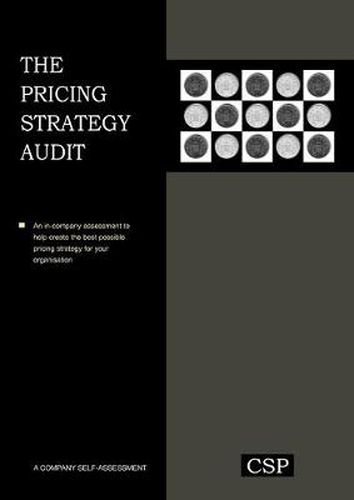Readings Newsletter
Become a Readings Member to make your shopping experience even easier.
Sign in or sign up for free!
You’re not far away from qualifying for FREE standard shipping within Australia
You’ve qualified for FREE standard shipping within Australia
The cart is loading…






This title is printed to order. This book may have been self-published. If so, we cannot guarantee the quality of the content. In the main most books will have gone through the editing process however some may not. We therefore suggest that you be aware of this before ordering this book. If in doubt check either the author or publisher’s details as we are unable to accept any returns unless they are faulty. Please contact us if you have any questions.
This detailed self-assessment audit can be used:
to measure and improve the effectiveness of your present pricing strategy
or to create a sound pricing strategy where none exists.
First, use the audit to understand the 5 factors to consider when setting prices - and how to balance them. Then get clear answers to questions like these:
Does your pricing strategy support broader corporate objectives?
Have you fully understood the influence of price on your customers?
Do you use price correctly as an indicator of product/service quality?
Do you use reference prices and differential prices effectively?
How well do you use breakeven and profit analysis?
Do you use appropriate pricing strategies at different stages in the product/service life cycle?
How do you use promotions and discounting?
Have you considered the legal issues? The audit doubles as a complete introduction to the whole question of how to set prices and calculate the consequences of your pricing decisions.
The audit’s 7 steps are:
Step 1: Assess the Consistency Between Corporate and Pricing Objectives
Step 2: Assess the Relevant Economics for the Pricing Strategy
Step 3: Determine How Your Buyers Perceive Prices
Step 4: Determine the Relevant Costs for the Pricing Strategy
Step 5: Determine the Characteristics of each Specific Price Decision
Step 6: Integrate Specific Price Decisions into an Overall Pricing Strategy
Step 7: Assess the Administrative Structure for Managing the Pricing Function.
$9.00 standard shipping within Australia
FREE standard shipping within Australia for orders over $100.00
Express & International shipping calculated at checkout
This title is printed to order. This book may have been self-published. If so, we cannot guarantee the quality of the content. In the main most books will have gone through the editing process however some may not. We therefore suggest that you be aware of this before ordering this book. If in doubt check either the author or publisher’s details as we are unable to accept any returns unless they are faulty. Please contact us if you have any questions.
This detailed self-assessment audit can be used:
to measure and improve the effectiveness of your present pricing strategy
or to create a sound pricing strategy where none exists.
First, use the audit to understand the 5 factors to consider when setting prices - and how to balance them. Then get clear answers to questions like these:
Does your pricing strategy support broader corporate objectives?
Have you fully understood the influence of price on your customers?
Do you use price correctly as an indicator of product/service quality?
Do you use reference prices and differential prices effectively?
How well do you use breakeven and profit analysis?
Do you use appropriate pricing strategies at different stages in the product/service life cycle?
How do you use promotions and discounting?
Have you considered the legal issues? The audit doubles as a complete introduction to the whole question of how to set prices and calculate the consequences of your pricing decisions.
The audit’s 7 steps are:
Step 1: Assess the Consistency Between Corporate and Pricing Objectives
Step 2: Assess the Relevant Economics for the Pricing Strategy
Step 3: Determine How Your Buyers Perceive Prices
Step 4: Determine the Relevant Costs for the Pricing Strategy
Step 5: Determine the Characteristics of each Specific Price Decision
Step 6: Integrate Specific Price Decisions into an Overall Pricing Strategy
Step 7: Assess the Administrative Structure for Managing the Pricing Function.